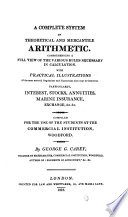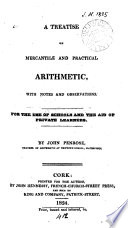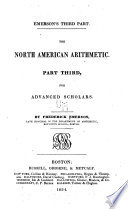 | Osgood Carleton - 1810 - 264 σελίδες
...there be a remainder in one, or both operations, multiply the first divisor by the last remainder ; to the product add the first remainder, the sum will be the true remainder. • EXAMPLES. 1 Divide 120456 by 21. 2 Divide 59Г364 by 35. 3 times 7 3)120456 5 times 7 5)597364... | |
 | George G. Carey - 1818 - 602 σελίδες
...divisors instead of one, if there should be any remainder in dividing by the second figure, multiply this remainder by the first divisor, and to the product add the first remainder (if any) and the sum will be the complete remainder*. * If there be no reminder in dirieing by the... | |
 | Henry Jackson - 1824 - 172 σελίδες
...tkercbc a remainder in the first or last division, or both, how •will you find the true remainder ? A. Multiply the last remainder by the first divisor, and to the product add the tii-st remainder, if any, and it will give the true one. NOTE. — Should there be no remainder in... | |
 | John Penrose (teacher of arithmetic.) - 1824 - 320 σελίδες
...division, must be strictly observed, when determining the fractional parts, that is, to multiply the second remainder by the first divisor, and to the product add the first remainder. When there are three component parts, multiply the third remainder by the second divisor, and to the... | |
 | William Ruger - 1832 - 282 σελίδες
...parts of the divisor, and then that quotient by tie other. How do you find the true remainder ? A. Multiply the last remainder by the first divisor, and to the product add the first remainder, and it wul give the true remainder. If your divisor be eight ?,rhat would you. call the component parts?... | |
 | Frederick Emerson - 1833 - 198 σελίδες
...divisor; what is the quotient? To obtain the true remainder, where factors have been used as divisors, multiply the last remainder by the first divisor, and to the product add the first remainder. 27. Suppose 622 to be a dividend, and 35 the divisor; what is the quotient; and what the remainder... | |
 | Frederick Emerson - 1834 - 204 σελίδες
...divisor; what is the quotient ? To obtain the true remainder, where factors have been used as divisors, multiply the last remainder by the first divisor, and to the product add the first remainder. 27. Suppose 622 to be a dividend, and 35 the divisor; what is the quotient; and what the remainder... | |
 | Frederick Emerson - 1834 - 300 σελίδες
...quotient thence arising by the other: the last quotient will be the true one. To find the true remainder, multiply the last remainder by the first divisor, and to the product add the first remainder. 1. Divide 4062900311 by 9, and prove the operation. 2. How many times is 502 contained in 74260710?... | |
 | Frederick Emerson - 1835 - 300 σελίδες
...quotient thence arising by the other: the last quotient will be the true one. To find the true remainder, multiply the last remainder by the first divisor, and to the product add the ftrst remainder. 1. Divide 4062900311 by 9, and prove the operation. 2. How many times is 502 contained... | |
 | Benjamin Greenleaf - 1839 - 356 σελίδες
...other, and the last quotient will be the answer to the question. NOTE. — To find the true remainder; multiply the last remainder by the first divisor, and to the product add the first remainder. 37. If 16 yards of velvet cost 2£. 18s. 8d. what will 1 yard cost ? 38. If 72 yards of broadcloth... | |
| |